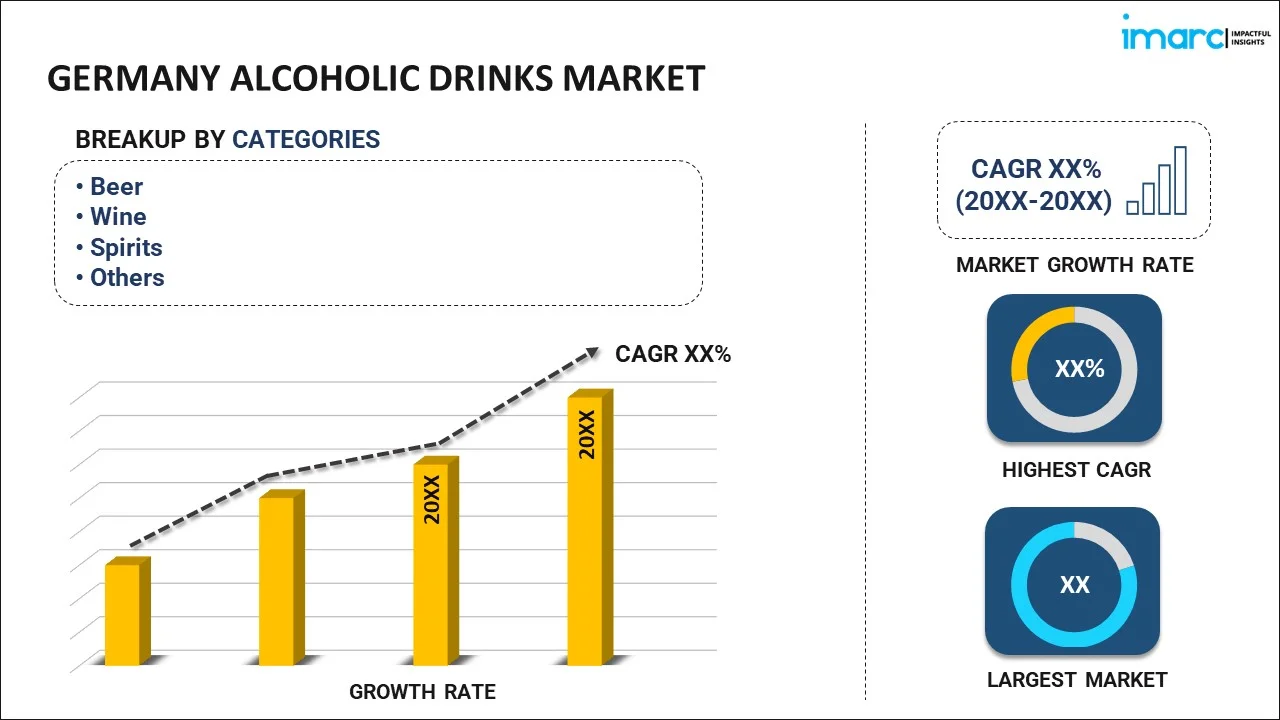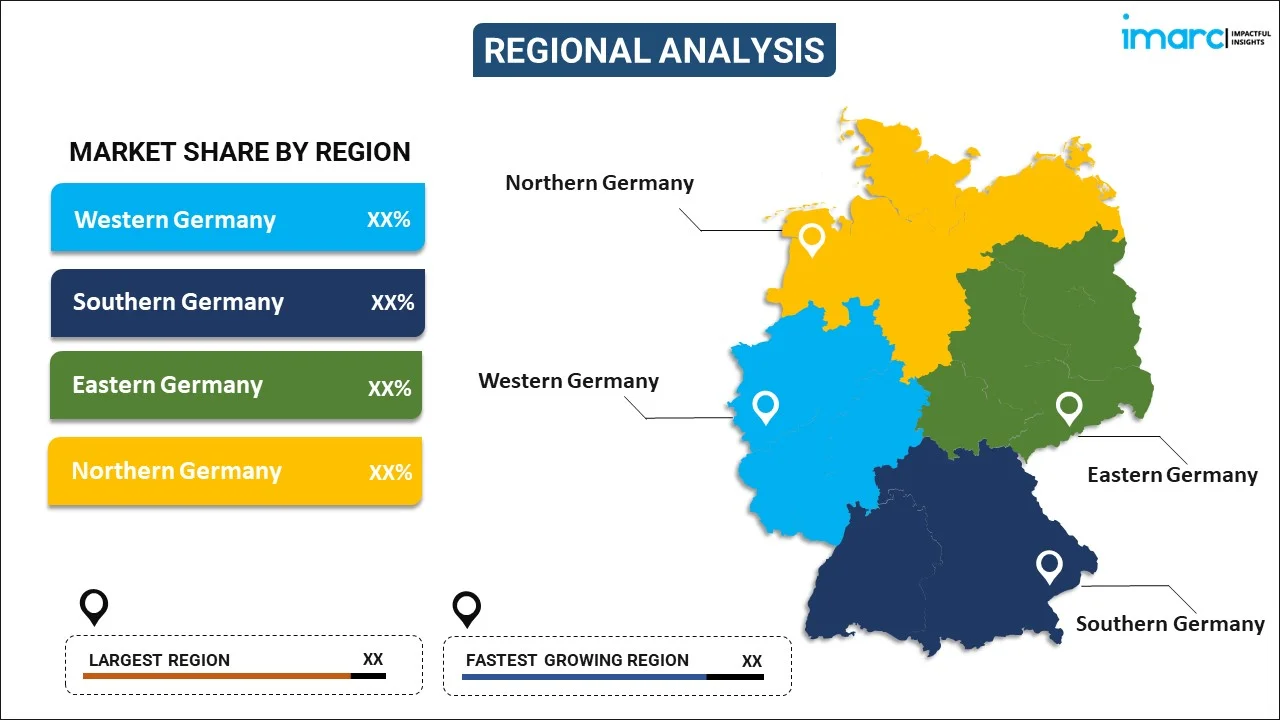
Germany Alcoholic Drinks Market Report by Category (Beer, Wine, Spirits, and Others), Alcoholic Content (High, Medium, Low), Flavour (Unflavoured, Flavoured), Packaging Type (Glass Bottles, Tins, Plastic Bottles, and Others), Distribution Channel (Supermarkets and Hypermarkets, On-Trade, Specialist Retailers, Online, Convenience Stores, and Others), and Region 2025-2033
Germany Alcoholic Drinks Market Overview:
The Germany alcoholic drinks market size reached USD 72.6 Billion in 2024. Looking forward, IMARC Group expects the market to reach USD 99.3 Billion by 2033, exhibiting a growth rate (CAGR) of 3.55% during 2025-2033. The market is mainly driven by a strong beer culture in the country, diverse wine production, and increasing interest in craft spirits. Key trends include premiumization, health-conscious choices like low-alcohol options, and growing e-commerce sales. The market remains dynamic with innovation in flavors and sustainable packaging.
|
Report Attribute
|
Key Statistics
|
|---|---|
|
Base Year
|
2024 |
|
Forecast Years
|
2025-2033
|
|
Historical Years
|
2019-2024
|
| Market Size in 2024 | USD 72.6 Billion |
| Market Forecast in 2033 | USD 99.3 Billion |
| Market Growth Rate (2025-2033) | 3.55% |
Germany Alcoholic Drinks Market Trends:
Digitalization in Online Sales
Ongoing digital transformations in Germany’s alcoholic drinks market is significantly reshaping the sales strategies. Driven by recent global events that limited physical retail operations, alcoholic beverages brands are rapidly adopting online sales channels to reach consumers directly. This shift has stimulated enhancement in digital marketing, e-commerce platforms, and mobile apps, allowing brands to offer personalized shopping experiences, real time customer service, and targeted promotions. According to a report published by International Trade Administration, Germany is one of the largest e-commerce markets in Europe, which can be attributed to strong internet penetration and high average annual spending. In 2022, total sales were estimated at 141.2 billion U.S. dollar, representing an 11% increase from year 2021. The online population in Germany is expected to grow from 62.4 million in 2020 to 68.4 million in 2025. E-commerce penetration reached 80% in 2022, ranking Germany as third highest across the world. This move towards digitalization not only caters to the growing consumer preference for convenience, but also opens new avenues for brands to expand their market presence and customer engagement.
Premiumization and Craft Beverages
In Germany, the alcoholic drinks market is witnessing a surge in the demand for premium and craft beverages, reflecting a broader global trend towards higher quality and unique local products. This movement is driven by consumers' growing appreciation for distinctive flavors and the craftsmanship behind beverage production. Nearly half (49%) of Germany’s consumers prefer drinking beer in bars and restaurants, making them valuable in the country's gastronomy market. The majority are male, over 55, and they earn above the national average too. While they tend to stick to familiar choices, there is a growing interest in experimenting with new and global options. They are willing to pay more for quality, and nearly three in four (72%) prefer pilsner when out. Microbreweries and small-scale distilleries are flourishing, supported by an enthusiastic consumer base that values the authenticity and story behind locally sourced ingredients and production methods. Additionally, specialty wines from regional vineyards are gaining prominence, appealing to both connoisseurs and casual drinkers looking for something beyond mainstream offerings. This trend towards premiumization not only caters to a niche market but also encourages diversity and innovation within the industry, as producers strive to create exceptional products that stand out in a competitive market.
Germany Alcoholic Drinks Market News:
- In 2024, Stock Spirits has introduced Amundsen Vodka to the German market following the success of Żołądkowa de Luxe. The vodka, inspired by Roald Amundsen's Antarctic expedition, boasts exceptional purity and a unique bottle design resembling a block of ice. Stock Spirits' Chief Marketing Officer, Hendrik Schatz, expressed excitement about the product's launch, emphasizing its distinctive packaging and appealing taste at an attractive price.
- In 2024, Diageo is partnering with PA Consulting to trial a paper-based packaging for Baileys Irish Cream Liqueur. The innovative Dry Molded Fiber bottle, which is 90% paper, aims to enhance sustainability without requiring consumers to separate plastic from paper during disposal. This trial, along with other eco-friendly packaging initiatives, aligns with Diageo's commitment to reduce its carbon footprint and meet consumer demand for more sustainable products.
Germany Alcoholic Drinks Market Segmentation:
IMARC Group provides an analysis of the key trends in each segment of the market, along with forecasts at the country level for 2025-2033. Our report has categorized the market based on category, alcoholic content, flavour, packaging type, and distribution channel.
Category Insights:

- Beer
- Wine
- Still Light Wine
- Sparkling Wine
- Spirits
- Baijiu
- Vodka
- Whiskey
- Rum
- Liqueurs
- Gin
- Tequila
- Others
- Others
The report has provided a detailed breakup and analysis of the market based on the category. This includes beer, wine (still light wine and sparkling wine), spirits (baijiu, vodka, whiskey, rum, liqueurs, gin, tequila, and others), and others.
Alcoholic Content Insights:
- High
- Medium
- Low
A detailed breakup and analysis of the market based on the alcoholic content have also been provided in the report. This includes high, medium, and low.
Flavour Insights:
- Unflavoured
- Flavoured
The report has provided a detailed breakup and analysis of the market based on the flavour. This includes unflavored and flavored.
Packaging Type Insights:
- Glass Bottles
- Tins
- Plastic Bottles
- Others
A detailed breakup and analysis of the market based on the packaging type have also been provided in the report. This includes glass bottles, tins, plastic bottles, and others.
Distribution Channel Insights:
- Supermarkets and Hypermarkets
- On-Trade
- Specialist Retailers
- Online
- Convenience Stores
- Others
The report has provided a detailed breakup and analysis of the market based on the distribution channel. This includes supermarkets and hypermarkets, on-trade, specialist retailers, online, convenience stores, and others.
Regional Insights:

- Western Germany
- Southern Germany
- Eastern Germany
- Northern Germany
The report has also provided a comprehensive analysis of all the major regional markets, which include Western Germany, Southern Germany, Eastern Germany, and Northern Germany.
Competitive Landscape:
The market research report has also provided a comprehensive analysis of the competitive landscape. Competitive analysis such as market structure, key player positioning, top winning strategies, competitive dashboard, and company evaluation quadrant has been covered in the report. Also, detailed profiles of all major companies have been provided.
Germany Alcoholic Drinks Market Report Coverage:
| Report Features | Details |
|---|---|
| Base Year of the Analysis | 2024 |
| Historical Period | 2019-2024 |
| Forecast Period | 2025-2033 |
| Units | Billion USD |
| Scope of the Report | Exploration of Historical Trends and Market Outlook, Industry Catalysts and Challenges, Segment-Wise Historical and Future Market Assessment:
|
| Categories Covered |
|
| Alcoholic Contents Covered | High, Medium, Low |
| Flavours Covered | Unflavored, Flavored |
| Packaging Types Covered | Glass Bottles, Tins, Plastic Bottles, Others |
| Distribution Channels Covered | Supermarkets and Hypermarkets, On-Trade, Specialist Retailers, Online, Convenience Stores, Others |
| Regions Covered | Western Germany, Southern Germany, Eastern Germany, Northern Germany |
| Customization Scope | 10% Free Customization |
| Post-Sale Analyst Support | 10-12 Weeks |
| Delivery Format | PDF and Excel through Email (We can also provide the editable version of the report in PPT/Word format on special request) |
Key Questions Answered in This Report:
- How has the Germany alcoholic drinks market performed so far and how will it perform in the coming years?
- What has been the impact of COVID-19 on the Germany alcoholic drinks market?
- What is the breakup of the Germany alcoholic drinks market on the basis of category?
- What is the breakup of the Germany alcoholic drinks market on the basis of alcoholic content?
- What is the breakup of the Germany alcoholic drinks market on the basis of flavour?
- What is the breakup of the Germany alcoholic drinks market on the basis of packaging type?
- What is the breakup of the Germany alcoholic drinks market on the basis of distribution channel?
- What are the various stages in the value chain of the Germany alcoholic drinks market?
- What are the key driving factors and challenges in the Germany alcoholic drinks?
- What is the structure of the Germany alcoholic drinks market and who are the key players?
- What is the degree of competition in the Germany alcoholic drinks market?
Key Benefits for Stakeholders:
- IMARC’s industry report offers a comprehensive quantitative analysis of various market segments, historical and current market trends, market forecasts, and dynamics of the Germany alcoholic drinks market from 2019-2033.
- The research report provides the latest information on the market drivers, challenges, and opportunities in the Germany alcoholic drinks market.
- Porter's five forces analysis assist stakeholders in assessing the impact of new entrants, competitive rivalry, supplier power, buyer power, and the threat of substitution. It helps stakeholders to analyze the level of competition within the Germany alcoholic drinks industry and its attractiveness.
- Competitive landscape allows stakeholders to understand their competitive environment and provides an insight into the current positions of key players in the market.
Need more help?
- Speak to our experienced analysts for insights on the current market scenarios.
- Include additional segments and countries to customize the report as per your requirement.
- Gain an unparalleled competitive advantage in your domain by understanding how to utilize the report and positively impacting your operations and revenue.
- For further assistance, please connect with our analysts.
 Inquire Before Buying
Inquire Before Buying
 Speak to an Analyst
Speak to an Analyst
 Request Brochure
Request Brochure
 Request Customization
Request Customization




.webp)




.webp)












